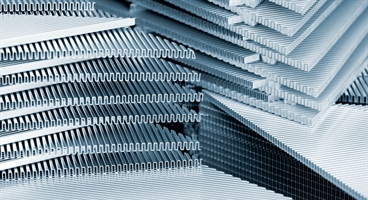In the ever-evolving landscape of industrial processes and energy management, the pursuit of thermal efficiency has become a driving force. Among the myriad solutions that have revolutionized heat transfer operations, plate fin heat exchangers stand out as a testament to ingenious engineering. These innovative devices have garnered widespread acclaim for their exceptional heat transfer capabilities, compact design, and adaptability, making them indispensable components across numerous industries. In this comprehensive article, we delve into the intricate world of plate fin heat exchanger, exploring their construction, operating principles, and the multitude of benefits they offer.
The Anatomy of a Plate Fin Heat Exchanger
At the heart of a plate fin heat exchanger lies a series of parallel plates, meticulously designed with intricate fin structures. These fins are strategically arranged along the plates, significantly increasing the effective heat transfer area. The plate-fin assembly is typically enclosed within a compact casing, allowing for efficient heat exchange between the fluids flowing through the unit.
One of the key advantages of plate fin heat exchangers is their modular design, which allows for easy customization and scalability to accommodate diverse process requirements. This adaptability makes them highly versatile solutions, capable of handling a wide range of fluids, temperatures, and heat transfer demands.
Operating Principles: Maximizing Heat Transfer Efficiency
Plate fin heat exchangers operate on the principles of conductive and convective heat transfer. The fluids, typically gases or liquids, flow through the alternating channels created by the parallel plates and fins. Heat is transferred from the hotter fluid to the colder fluid through the conductive heat transfer within the plate material, while the extended surface area provided by the fins facilitates efficient convective heat transfer between the plates and the fluids.
The intricate fin design significantly enhances the overall heat transfer rate, resulting in superior thermal efficiency compared to conventional smooth-walled heat exchangers. This design characteristic makes plate fin heat exchangers ideal for applications where space constraints or weight limitations are critical factors.
Benefits and Applications
- Exceptional Heat Transfer Efficiency: Plate fin heat exchangers excel in their ability to transfer heat efficiently, resulting in significant energy savings and reduced operational costs.
- Compact Design: With their space-saving configuration, these exchangers offer a compact footprint, making them suitable for installations where space is at a premium.
- Versatility: Plate fin heat exchangers can handle a wide range of fluids, temperatures, and heat transfer demands, allowing for diverse applications across multiple industries.
- Customizability: The plate and fin designs, materials, and configurations can be tailored to specific application requirements, ensuring optimal performance and durability.
- Scalability: The modular nature of plate fin heat exchangers allows for easy capacity adjustments, ensuring adaptability to changing process requirements.
Plate fin heat exchangers have found widespread applications across various industries, including:
- Power Generation: In power plants, these exchangers are employed in condensers, feedwater heaters, and waste heat recovery systems, contributing to overall efficiency and energy conservation.
- HVAC and Refrigeration: Plate fin heat exchangers play a crucial role in heating, ventilation, air conditioning, and refrigeration systems, facilitating efficient heat transfer and energy recovery.
- Automotive and Transportation: These exchangers are essential components in automotive applications, such as charge air coolers, radiators, and oil coolers, ensuring efficient thermal management.
- Chemical Processing: The chemical industry relies on plate fin heat exchangers for processes such as distillation, evaporation, and heat recovery, where efficient heat transfer is critical.
- Aerospace and Defense: The compact and lightweight design of plate fin heat exchangers makes them suitable for various aerospace and defense applications, including aircraft environmental control systems and electronics cooling.
Advancements and Future Outlook
As industries continue to prioritize energy efficiency and sustainable practices, the demand for optimized plate fin heat exchangers is expected to grow. Ongoing research and development efforts are focused on enhancing heat transfer rates, exploring new materials, and integrating advanced monitoring and control systems.
One notable advancement is the incorporation of additive manufacturing techniques, such as 3D printing, in the production of plate fin heat exchangers. This approach allows for the creation of intricate and optimized fin designs, improving heat transfer performance and reducing material waste.
Additionally, the integration of advanced sensors and predictive maintenance technologies enables real-time monitoring of operating conditions, enabling proactive maintenance and optimizing the overall lifecycle of these critical components.
Conclusion
In the relentless pursuit of thermal excellence and sustainable industrial operations, plate fin heat exchanger have emerged as true game-changers. Their compact design, exceptional heat transfer capabilities, and versatility have made them indispensable components across a wide range of industries. From power generation to HVAC and refrigeration, automotive applications to chemical processing, these remarkable devices continue to push the boundaries of energy efficiency, ensuring optimal resource utilization and minimizing environmental impact. As technology continues to advance and industries strive for greener and more cost-effective solutions, the role of plate fin heat exchangers will only become more pivotal. With their scalability, customizability, and ease of maintenance, they offer a future-proof solution that can adapt to changing process requirements and evolving environmental regulations. Ultimately, plate fin heat exchangers represent a testament to human ingenuity and the ongoing pursuit of thermal prowess, paving the way for a more energy-conscious and environmentally responsible industrial landscape.



